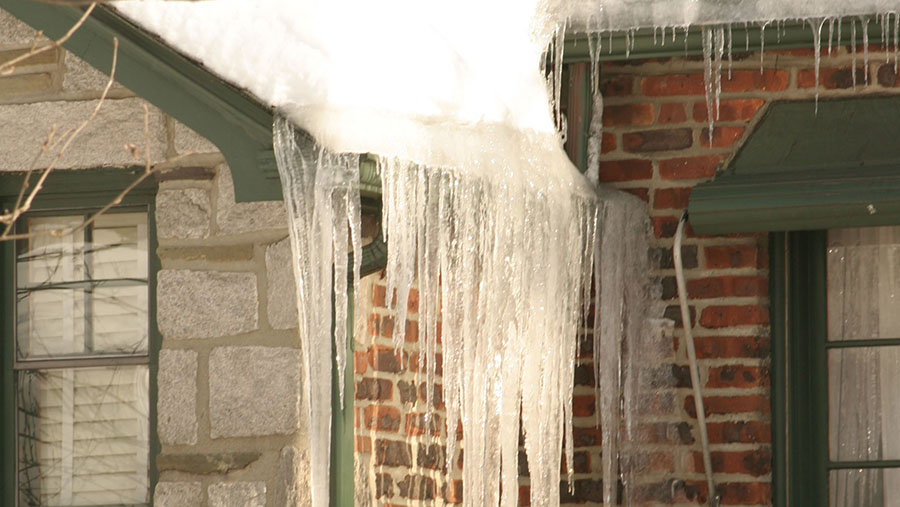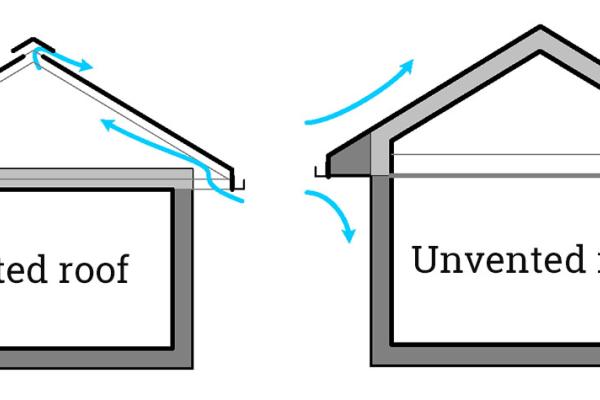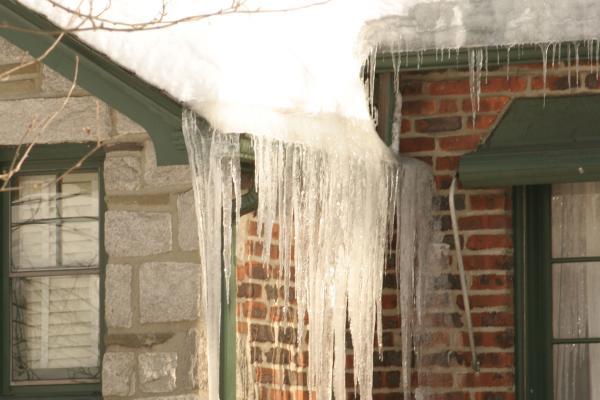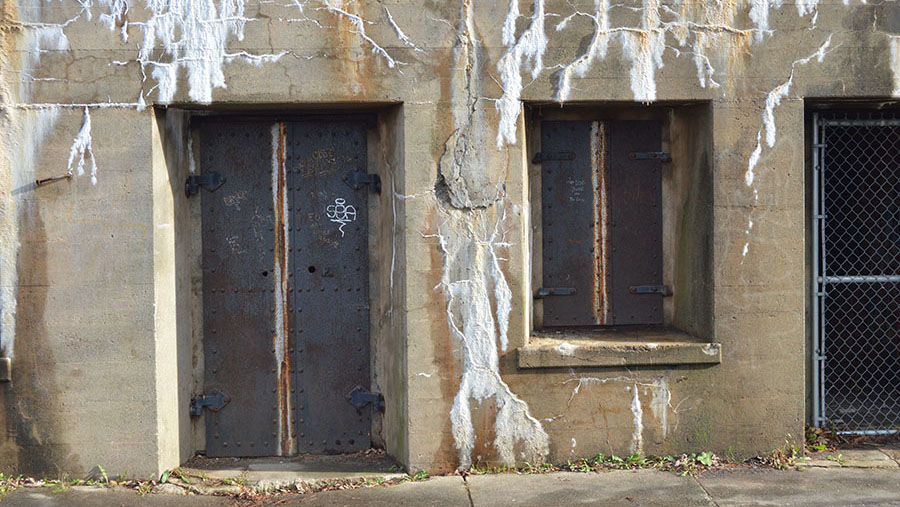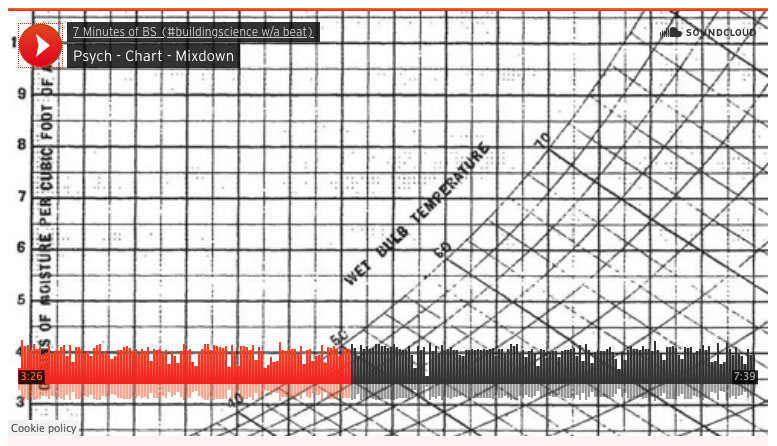A big problem, for roofs in cold climates, but what causes it and how can you fix it?
What it is:
ice dam | īs dam (n)
"The buildup of ice in an area of the roof where there is a temperature difference that causes melting of snow and freezing of the water at the same time, in different areas".
—Jonathan Smegal, RDH Building Science Labs
How it works:
Snow melts on a warm part of the roof and the water dribbles down to a cold part, where it freezes.
"This means that different areas of the roof that get heated up by either interior air or by heat loss from the inside, the snow will melt in those areas and it will run to—Normally the edge of the roof is where we see the most ice damming—and then it will refreeze, backing up the roof—which is why it’s called a dam."
The damn ice prevents the water from escaping. The source of the heat is usually indoor air—heat leaks from the inside, sneaking through holes in the ceiling and skimpy insulation.
The melt water flows down hill until it hits a cold spot, usually just past the outside wall. At this point, there is no more heat source.
Just winter.
Ice damming is not confined to roof edges. "It can also occur in valleys, where there might be more thermal bridging, or less ventilation… ...or it could happen at chimneys, where the chimney gets warm, it melts the snow, and then the water refreezes."
"So it can happen in other areas, but the most common spot, when you are driving down the road is at the edge of the roof and you see these massive icicles hanging down."
But not just little icicles, like kids have sword fights with...
"When we are talking about ice damming, we are talking about a massive piece of ice that can cause property damage, it also can cause leakage back into the attic as it pushes up between the shingles as it freezes back up the roof."
"So we are talking about relatively large chunks of ice, not just the icicles we play with as kids."
"The most typical reason that ice dams occur is the air inside the attic becomes warm, and it heats the roof deck. The two contributing factors to the warmth inside the attic space are usually lack of attic ventilation of exterior cold air, or too much interior air leakage."
Interior air that leaks through the ceiling
"If it is not airtight enough, it will allow warm air from the interior of the house into the attic." And if the ventilation is not ventilating, the attic space becomes warm enough to melt some of the snow."
So technically, there is another contributing factor to ice dams beyond a warm attic and bad ventilation: snow on the roof.
"To get ice damming you do need snow on the roof. You do not need that much, only a small dusting and you can start the ice damming."
But a dusting will not cause a dam. At least not one that gets any damn attention—you need a lot of snow for that. And something mysterious happens when you get a LOT of snow: the snow actually CAUSES the ice dam.
"Ice damming is complicated by the fact that when you get a lot of snow on the roof, you actually accumulate a significant R-value, or thermal layer of snow."
A fluffy blanket of insulation on top of the roof.
"Depending on the density, you can get about R-1 per inch. In some places where you get a lot of snow, you can get R-15, R-20, R-25—on top of the roof deck."
This homemade cap from Mother Nature can have a strange and surprising affect. It has the same effect as intentionally putting insulation outside a house: it warms the framing.
"So you can imagine if you start insulating the top of the roof deck, from the outside, all of a sudden the roof deck is going to get warmer—because it is closer to the inside temperature."
"So when that happens, when you get a lot of snow in some of these cold locations, that alone will cause ice damming because the roof deck— even in the best cathedral ceiling assembly—will be above the freezing point and start to melt snow from the bottom of that snow pack."
How to Fix it:
Solutions to ice dams are varied because the circumstances to them are varied. It is also difficult to build ceilings that are air tight, because there are so many holes in them
"That is one reason that in a lot of locations there is a requirement for a peel and stick waterproof membrane under the shingles along the bottom of the roof line, to prevent water from getting into the attic or into the enclosure if ice damming occurs."
This doesn’t prevent ice dams, it just reduces the ice damage.
In those heavy snow areas, ski bums can earn lift ticket and beer money by shoveling roofs to prevent ice dams. But anyone who knows ski bums could predict that ski bums ...
"can actually cause a lot of damage to the roof—and personal injury by slipping off. So that is not one of the best ways of getting rid of ice dams."
But there are ways to avoid the problem in the first place. And they are rather mundane …
"In some locations they use a metal edge to the roof that acts as a slip plane, so the ice doesn’t build up there, it will just slip off."
Just watch where you are walking in the winter.
"Some people use electrical resistance heater wiring in some sort of zig-zag pattern along the edge of the roof which helps stop the ice build up by just melting the ice and snow."
But that is just throwing good heat after bad ice.
"But the best way to stop ice dams it to make sure that your attic ventilation is enough and the ceiling plane and interior partition walls are airtight to the attic.
There are many ways in which air leakage can occur into the attic through partition walls, the wiring, pot lights, fans, anything in the ceiling..."
Beyond air sealing and ventilation, is insulation. For example, in an unvented attic with exterior insulation, you move the roof deck inside the thermal envelope of the house.
"The reason this works well is because it’s harder to get the variations in temperature from one area of the roof to the other."
Because the insulation (in an exterior insulated assembly) maintains a constant temperature of the roof deck, and eliminates thermal bridges.
"The only place that exterior insulation can run into some difficulty is in high, high snow areas, like ski resorts." In which case, an airtight and insulated roof is capped with furring strips, plywood, and roofing to make a vented roof over an insulated roof.
"As long as there is an air barrier in there, it should work quite well."
—Remember you get paid for what you do and what you know. You cannot always do more, but you can always know more—with ProTradeCraft.
![]()
—If you like this podcast, share it through Facebook, Twitter, LinkedIn, SnapChat, or however you reach out to your peeps.
![]()
